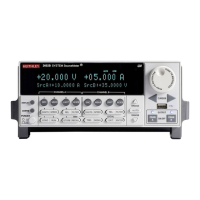Quick Results Guide 35
HILIM - Use to enter the high limit value. You will then be prompted to enter the bit pattern
for binning operations. Since binning operations are being done at this time, simply press
ENTER or EXIT.
Limit testing operation
1. Connect the DUT to the SourceMeter.
2. Configure the source-measure functions of the SourceMeter.
3. Select and configure a limit test as previously explained.
4. Turn the output on.
5. Press the LIMIT key to enable the test. The pass/fail status of the test will be displayed.
The test can be disabled by again pressing the LIMIT key.
Remote command programming
SCPI commands
SCPI commands for basic non-binning limit testing are listed in Table 17.
NOTE Table 17 does not provide a complete listing of limit commands. See Sections 12 and
18 of the 2400 Series SourceMeter User’s Manual for complete documentation.
Table 17
SCPI commands; basic non-binning limit testing
Command
*
Description
*
For all limit tests:
:CALCulate2:DATA? Acquire limit test reading(s).
Limit 1 test:
:CALCulate2:LIMit:STATe <b> Enable/disable Limit 1 test; <b> = ON or OFF.
:CALCulate2:LIMit:COMPliance:FAIL <.name> Set Limit 1 fail condition; <name> = IN (fail if in
compliance) or OUT (fail if not in compliance).
:CALCulate2:LIMit:FAIL? Query Limit 1 test result (0 = pass, 1 = fail).
Limit 2, 3, 5-12 tests:
:CALCulate2:LIMitX:STATe <b> Enable/disable Limit X test; <b> = ON or OFF.
:CALCulate2:FEED <name> Select input path; <name> = CALCulate[1],
VOLTage, CURRent or RESistance.
:CALCulate2:LIMitX:LOWer <n> Set lower limit for Limit X; <n> = limit.
:CALCulate2:LIMitX:UPPer <n> Set upper limit for Limit X; <n> = limit.
:CALCulate2:LIMitX:FAIL? Query Limit X test result (0 = pass, 1 = fail).
*LIMitX = LIMit2, LIMit3, LIMit5 through LIMit12.

